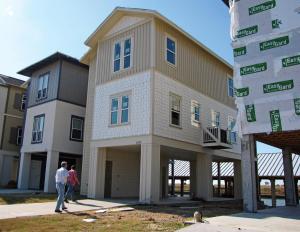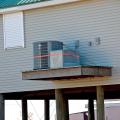Scope
In locations prone to earthquakes, tornadoes, hurricanes, or floods, anchor, and secure outdoor HVAC equipment to reduce the risk of damage to people, property, and the equipment itself.
- Protect outdoor HVAC systems from floodwater damage.
- Prevent outdoor HVAC equipment from falling or getting hit by wind-blown debris during high-wind events.
- Prevent outdoor HVAC equipment from tipping over or being dislodged due to earthquakes.
See the Compliance tab for links to related codes and standards and voluntary federal energy-efficiency program requirements.
Description
For most home air conditioning and heat pump systems, the compressor, the condenser coil, and the condenser fan are located in an outdoor unit outside of the home while the evaporator and evaporator coil are located in the air handler, which is an indoor unit located inside the home. In cooling mode, the heat pump absorbs heat inside the home. This heat is transferred to the outside unit through a pipe carrying refrigerant and then released outdoors via the condenser. The condenser should not be located in an attic, basement, garage, or crawlspace. Outdoors is the proper location for the condenser unit. However, this leaves the outside unit vulnerable to the elements, especially in locations prone to flooding, hurricanes, and earthquakes (Figure 1).
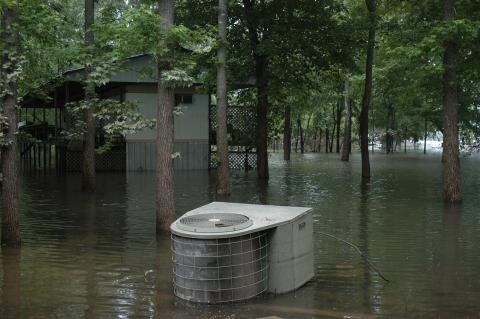
In locations subject to flooding, there are three ways to protect exterior service equipment: elevate it, relocate it, or protect it in place. More information on these methods can be found in Protecting Building Utilities from Flood Damage (FEMA P-348 2017).
Elevation
Equipment that is typically placed on the ground (e.g., the outdoor unit for air conditioners and heat pumps) can be raised above the flood elevation on pedestals or platforms (FEMA P-348 2017), as shown in Figures 2 and 3. Floodwaters are likely to completely destroy the electrical components of the outdoor HVAC equipment. If the equipment is submerged for even a brief amount of time, the electrical equipment could short circuit and the condenser could fill with sand or silt (FEMA P-348 2017). The condenser coil and compressor are often the most expensive components to replace. HVAC equipment installed outside the home should be elevated to at least 1 foot above the base flood elevation (BFE), similar to the requirement for living areas of newly constructed homes.

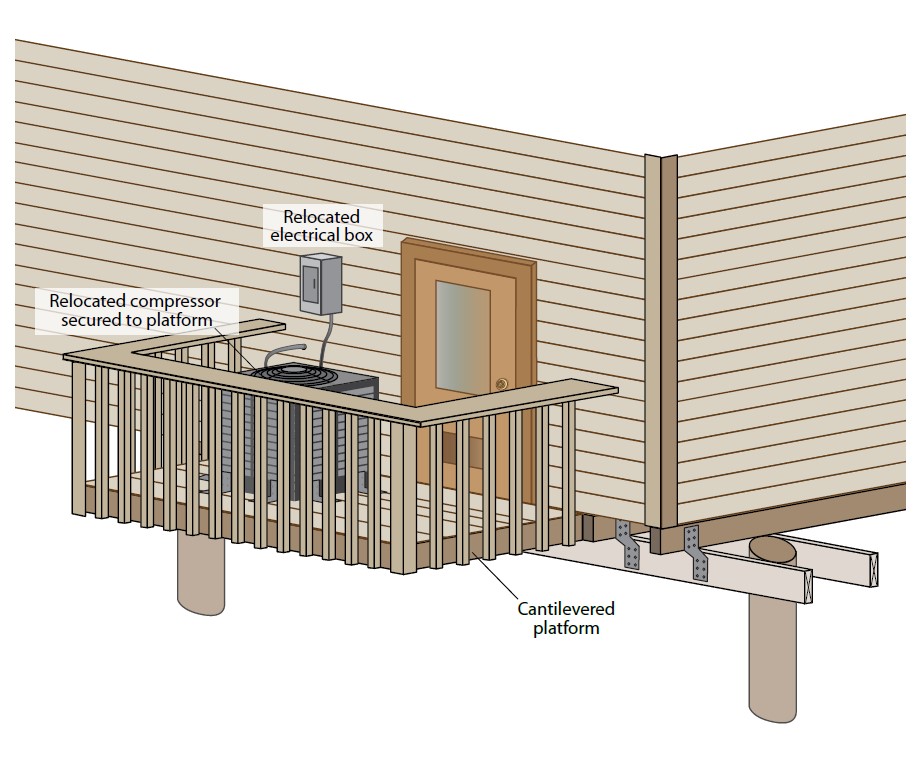
Outdoor HVAC units, including condensers, can be elevated on a base of masonry, concrete, pressure-treated lumber decking attached to the house, or an existing balcony or porch landing, as long as the HVAC equipment sits at least 1 foot above the base flood elevation (BFE) and the structure it sits on can withstand flood, wind, and earthquake forces. The equipment should also be secured to the building or elevating structure to resist movement in the event of high winds, wave action, or earthquakes. The pad or platform should be properly anchored to the floor system or slab, and the equipment should be properly anchored to the pad. For retrofits, this approach requires temporary removal of equipment, relocation while the platform or frame is constructed, and re-installation at the new, higher elevation (Home Innovation Research Labs 2012). Costs to have a 6-ft wooden platform constructed next to the house and to relocate the existing HVAC compressor and the emergency disconnect box, extend the refrigerant line, recapture old refrigerant, and recharge the lines could add up to a few thousand dollars to elevate the equipment 1 foot above the base flood elevation. It is often not much more expensive to raise the equipment 2 feet and may be worth considering for the extra measure of flood protection it can provide. An ideal time to elevate the outside HVAC unit is when the HVAC equipment needs to be replaced (Home Innovation Research Labs 2012). When elevating the outside unit, consider installing energy-efficient equipment to receive the benefits of energy efficiency and disaster preparedness (Home Innovation Research Labs 2012).
Indoor equipment should also be elevated. HVAC equipment should not be located in the basement or crawlspace if the home is located in an area where there is a high likelihood of flooding. Equipment located in the garage or on the first floor should be elevated at least one foot above the base flood elevation. (See Figure 4.) Heat-generating HVAC systems should have appropriate clearances to combustible surfaces when elevated.
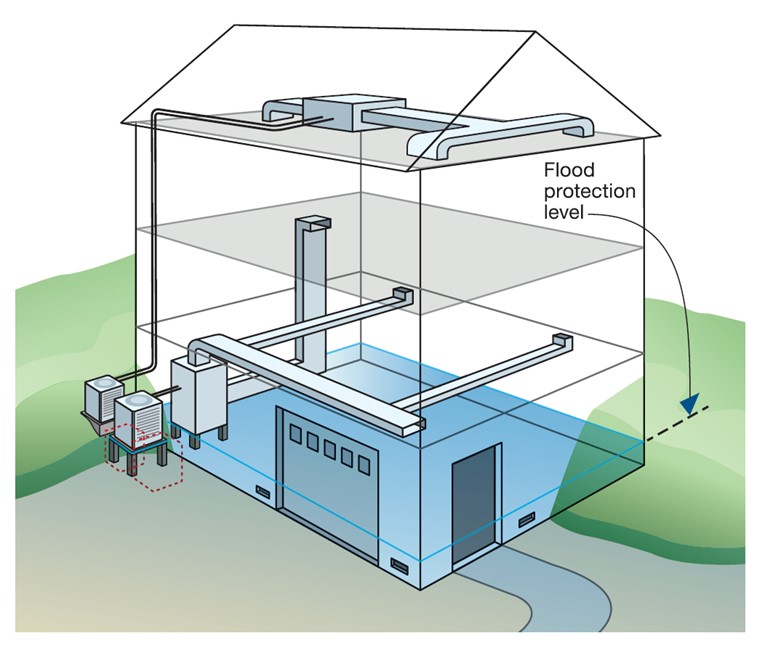
Access and required clearances must be maintained for servicing, repairs, and component replacement. Specific clearances to combustible and working space can be found in manufacturers’ installation manuals (FEMA P-348 2017).
Factors to consider when elevating primary HVAC components:
- When HVAC equipment is elevated, exhaust equipment must also be elevated to allow condensation (for condensing units) to drain properly. Vents should slope upwards.
- Elevated surfaces must be able to adequately support and anchor the weight of the HVAC equipment (FEMA P-348 2017).
- If not placed on a balcony cantilevered from the building, outdoor elevated HVAC equipment should be supported by piles or a masonry or concrete platform that extends below the expected depths of erosion, scour, and frost (FEMA P-348 2017).
- Maintain required horizontal and vertical clearances around the equipment, typically 36 to 56 inches.
- If elevating combustion equipment, conduct a combustion safety test to verify that the equipment can adequately draw combustion air and vent combustion byproducts. Or, use this opportunity to upgrade to sealed-combustion, direct-vented equipment.
Relocation
External HVAC equipment can be relocated to higher ground near the home, if there is a nearby slope on the property. Any HVAC equipment located in the basement or crawlspace should be relocated to an upper floor or attic within the home, or a first-floor location at least 1 foot above the base flood elevation (FEMA P-312 2014; FEMA P-348 2017).
Protection in Place
When elevation and relocation are infeasible or impractical, you may be able to protect service equipment in place with low floodwalls and shields and with anchors and tie downs that prevent flotation, see Figure 5. This approach is called dry floodproofing.
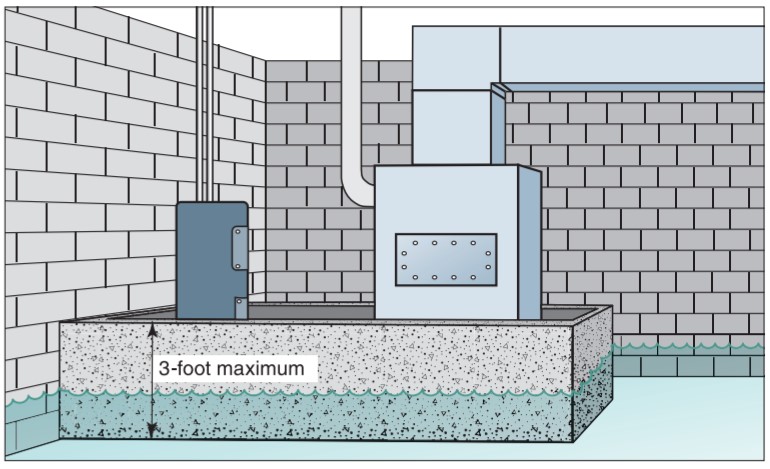
Dry floodproofing is not allowed for primary components like HVAC units, boilers, and water pumps to be compliant with the National Flood Insurance Program (NFIP) New Construction or Substantial Improvement standards (FEMA P-348 2017).
Secondary HVAC components
Like primary components of HVAC systems, most secondary components can be damaged or destroyed by floodwater (FEMA P-348 2017). Air handling components are particularly vulnerable because of the common practice of installing ductwork in crawlspaces or basements below the living space and supplying conditioned air from floor grills and registers, which exposes ductwork to flood damage. The most effective strategy for protecting secondary components is to elevate them, above the base flood elevation level. Elevating ducts can be done by the following:
- Suspend ducts from floor framing if framing is of sufficient height to allow ducts to be elevated at least 1 foot above the BFE.
- Move ducts to the attic.
- Locate ducts above dropped ceilings or conceal them in soffits within the living space above the home (this also protects the ducts from attic temperature extremes and can improve their energy efficiency or performance) (FEMA P-348 2017) (Figure 6).
- Locate the ducts in floor joists between floors.
- Consider replacing the ducted system with ductless minisplit heat pumps that are located high up on walls or with short-ducted minisplit systems located in the top of a central closet.
Ducts that run parallel to framing often can be installed between floors but this option is not available where ducts need to run perpendicular to framing (FEMA P-348 2017). Open-web, parallel-chord trusses may offer space to route ducts (particularly for flexible ducts), but solid framing (dimensional lumber) or prefabricated wood I-joists typically used in residential construction do not allow the routing of ducts through framing members. When ducts need to be routed perpendicular to solid framing, they can only be run either above or below that framing (FEMA P-348 2017).

Securing HVAC Equipment for Protection from Earthquake Activity
While nothing can prevent all possible damage to HVAC equipment in an earthquake or flood, there are some things installers and homeowners can do to reduce the likelihood of damage:
- Vibration isolators: These are spring-type devices installed at the bottom of your unit that allow it to absorb some movement so the internal components aren’t damaged in an earthquake. This feature can also be installed on the fan housing inside a large HVAC unit, but in areas prone to seismic activity, vibration isolation on the unit itself is essential to prevent the entire unit from being affected by seismic shaking. This isn’t a standard part of a unit, so the HVAC technician should install them when installing the equipment.
- Restraint brackets or seismic snubbers: These are brackets that go on the corners of the HVAC unit to help support the vibration isolators. They’re designed to reduce the shock to equipment from seismic vibrations. They can also be installed as a retrofit measure on existing home units.
- Flex-line piping: The condensate and gas piping from the HVAC system is often made of a rigid material that can crack and break during an earthquake. These hard lines should be replaced with flexible piping, or a piece of flexible piping should be inserted into these lines to absorb vibrations so the rigid pipe doesn’t break.
- Seismic certification: HVAC equipment manufacturers can test and receive a seismic certification on HVAC equipment. In California, this voluntary certification is issued to manufacturers by the Office of Statewide Health Planning and Development (OSHPD).
- After an earth quake, check to make sure equipment hasn’t shifted off pads. Check all lines for leaks. Check ducts for disconnections and air leakage. Replace cracked, dented, damaged, or leaking equipment.
How to Anchor HVAC Equipment for Seismic Restraint
- Install two restraining brackets on each corner of the HVAC unit (Figure 7). Brackets can be steel angles or bent plates extending 4 to 6 inches in each direction.
- Bolt to the supporting solid wood framing or concrete. For concrete, use one expansion bolt per bracket, 5/8-inch diameter X 4 inches long. For wood, use two lag bolts at 3-inch spacing per bracket, 5/8-inch diameter X 6 inches (Figure 7).
Or, instead of brackets, use seismic snubber brackets designed for this purpose (Figure 8). Provide two snubbers at each corner of the unit. Bolt to framing or concrete support, providing sufficient free play to allow the unit to vibrate under normal use.
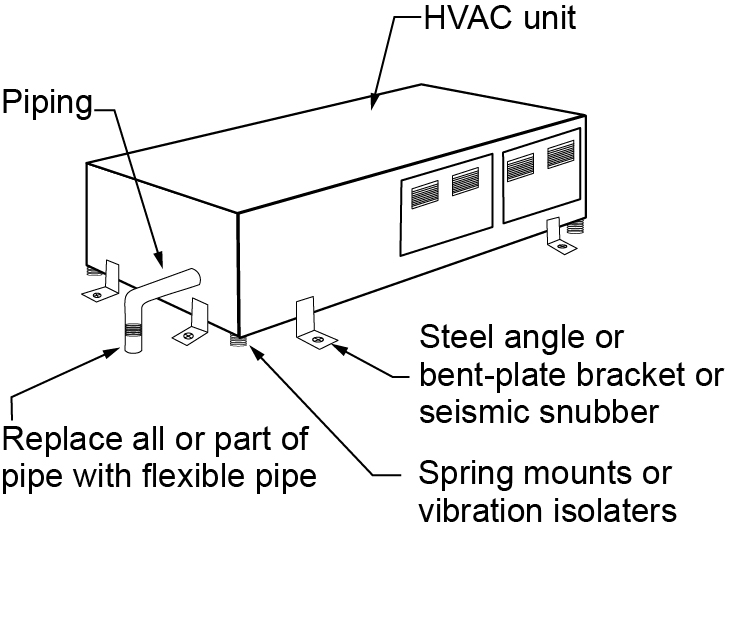
- Install a spring mount or vibration isolator in each corner of the unit as shown in Figure 8.
- Add flex lines to fuel or condensate lines to minimize breakage of lines in the event of an earthquake.
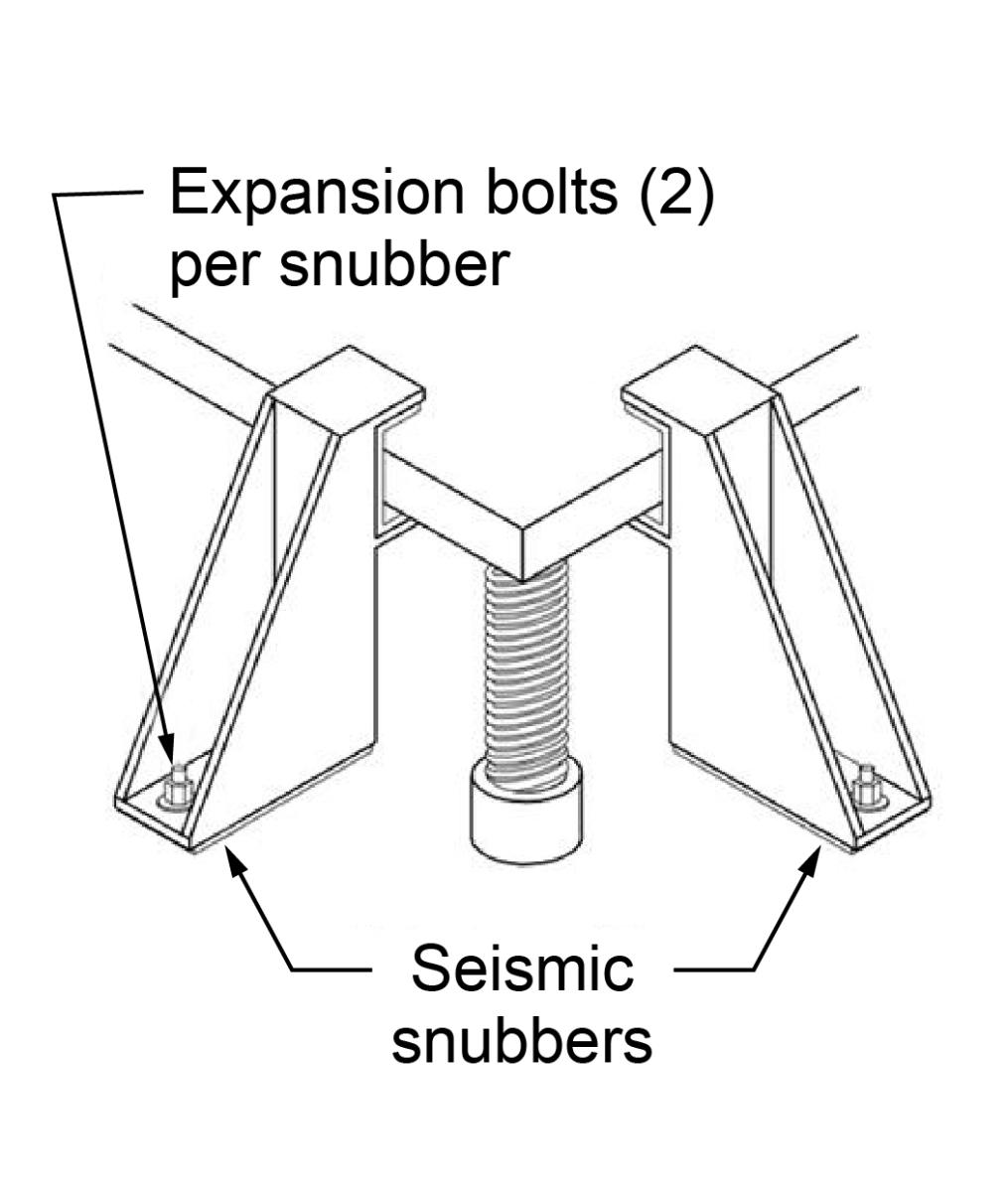
Success
All indoor and outdoor HVAC equipment must be located or relocated at least 1 foot above the base elevation for homes located in areas likely to flood.
Climate
In locations prone to hurricanes, high winds, and coastal flooding, the following can be incorporated into the site plan to increase the disaster resistance of the home:
- Any large equipment elevated on platforms or pedestals, both inside and outside your home, may be more vulnerable to wind and earthquake damage and may require additional bracing or anchorage. A design professional must determine the expected wind and earthquake forces at the site and account for them in the elevated platform design (FEMA P-348 2017).
- Where possible, pedestals and platforms should be located on the landward side (in coastal areas) or downstream side (in riverine areas) of homes to minimize the risk of impact from flood-borne debris. In coastal areas, the lowest horizontal member supporting the equipment or platform should be above the required flood protection elevation to avoid damage from breaking waves (FEMA P-348 2017).
- In coastal areas, anchors and straps should be stainless steel or hot-dip galvanized to resist salt spray and corrosion (FEMA P-348 2017).
Training
Compliance
Retrofit
The information provided in this guide applies to both new and existing homes.
More
More Info.
Access to some references may require purchase from the publisher. While we continually update our database, links may have changed since posting. Please contact our webmaster if you find broken links.
The following authors and organizations contributed to the content in this Guide.
